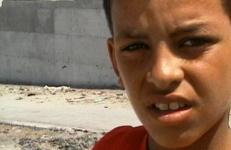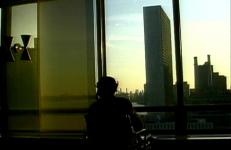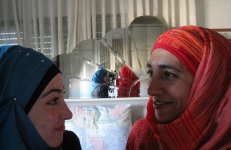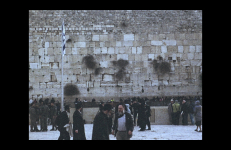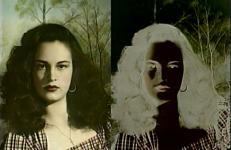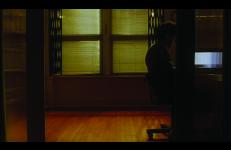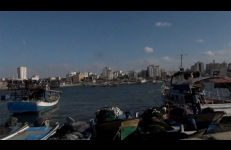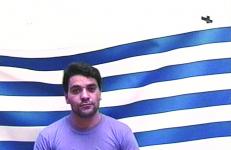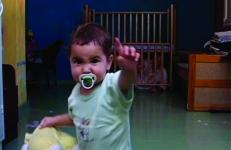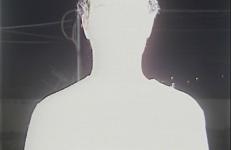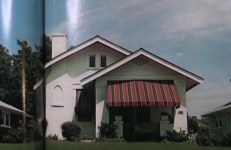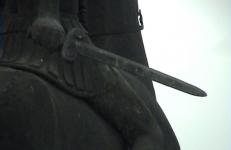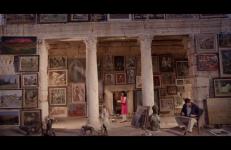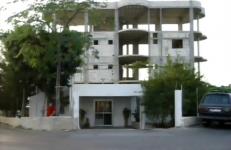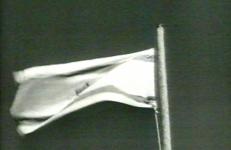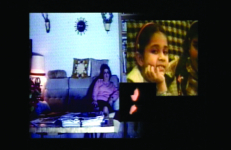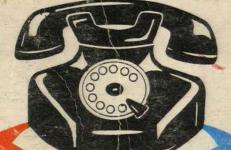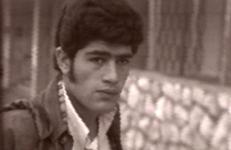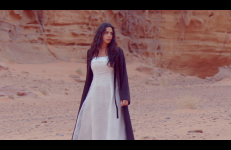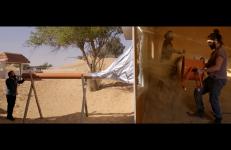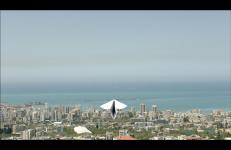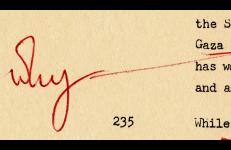Forbidden to Wander chronicles the experiences of a 25-year-old Arab American woman traveling on her own in the occupied territories of the West Bank and Gaza Strip during the summer of 2002. The film is a reflection on the complexity of Palestinian existence and the torturously disturbing “ordinariness” of living under constant curfew. The film’s title reflects this, as the Arabic words used to describe the imposed curfew “mane’ tajawwul” literally translate as “forbidden to wander”.
Middle East
This installation is based on the re-enactment of Franz Kafka’s allegory "Before the Law", interpreted live over a telephone line by Katharine Gun. Gun was a translator (specializing in Chinese to English translations), working with the British secret service, who chose to leak information compromising the U.S. and U.K. governments in their push for a U.N. resolution for the invasion of Iraq.
Nurit Sharett visited the city of Hebron over the course of a year, teaching video art to a group of young Palestinian women. Over time the artist established firm relationships with three of her students and their families. The video documents everyday life in that microcosm, dissimilar to any other city.
ḤARAM is an essay film portraying the urgent contemporary situation at the Haram Al Sharif/ Noble Sanctuary in the Old City of Jerusalem reflecting on the growing Temple Mount Faithful movement whose goal is to build the Jewish Third Temple on this holy landscape and in turn to assert Jewish sovereignty over this holy Muslim site.
Director and Editor: Cynthia Madansky
Cinematographer: Michele Paradisi
With Nazmi Al Jubeh and Avital Itzhak
Sound Design: Binya Reches
Graphic Design: RRNR Studio
A portrait of a studio photographer, Her + Him VAN LEO also examines the photography of the 1940s and 50s from a critical perspective rather than a nostalgic one. This documentary utilizes traditional portrait photography and video in a dialogue between two media: crafted black and white print, and the electronically colored and manipulated screen. This dialog comments on the transformations in art practices and terminologies, and evokes some of the social/urban/political transformations that took place in Egypt over 50 years of its recent history.
A Palestinian filmmaker is writing a script in his New York apartment during the first Gulf war. As much as he tries to shut himself off from the exterior world, images of past wars in the Middle East come back to haunt him.
This title is available on Radical Closure and for single screenings upon request.
Home Movies Gaza introduces us to the Gaza Strip as a mircrocosm for the failure of civilization. In an attempt to describe the everyday of a place that struggles for the most basic of human rights, this video claims a perspective from within the domestic spaces of a territory that is complicated, derelict, and altogether impossible to separate from its political identity.
"... Basma Alsharif’s Home Movies Gaza, a film that captures the impossibly politicized domestic sphere of the Gaza Strip, under the constant hum and buzz of overhead drones."
Hostage: The Bachar Tapes (English Version) is an experimental documentary about "The Western Hostage Crisis." The crisis refers to the abduction and detention of Westerners like Terry Anderson, and Terry Waite in Lebanon in the 80s and early 90s by "Islamic militants." This episode directly and indirectly consumed Lebanese, U.S., French, and British political and public life, and precipitated a number of high-profile political scandals like the Iran-Contra affair in the U.S.
Hostage: The Bachar Tapes (English Version) is an experimental documentary about "The Western Hostage Crisis." The crisis refers to the abduction and detention of Westerners like Terry Anderson, and Terry Waite in Lebanon in the 80s and early 90s by "Islamic militants." This episode directly and indirectly consumed Lebanese, U.S., French, and British political and public life, and precipitated a number of high-profile political scandals like the Iran-Contra affair in the U.S.
This work is almost a parable, where a man is imprisoned under his baby’s bed. He tries all means to survive and to find a mechanical solution that would lead him to freedom.
This title is only available on Radical Closure.
How I Love You is an exploration of sexuality among gay men in Lebanon. A couple and three individuals talk about their sex lives, about commitments and failures, about their relationships to their bodies, about their passions and love in a society where homosexuality is still punished by imprisonment. The video uses light to produce a white veil that obstructs seeing, hence rendering character identification almost impossible. Through this obstruction, the video locates itself within a specific social context.
The interior was delusional like any visual psyche. The couches and plants, rugs and paintings were all in cahoots and up in arms over the cahootery. The explorers were under-qualified and cowardly.
This short animation explores various ways to narrate an incident that once took place in the mythical Hotel Carlton. Against images of the deserted hotel today, the artist sketches situations that evoke the rumors that once circulated around the place and the people who inhabited it.
This title is only available on Radical Closure.
Museum collections of various kinds are the object of artist Dana Levy's ongoing, consistent study in the past decade.
Following the Israeli withdrawal from Ain el Mir in 1985, the village became the frontline. The Dagher family was displaced from their home, which was occupied by a radical resistance group for seven years. When the war ended in 1991, Ali Hashisho, a member of the Lebanese resistance stationed in the Dagher family house, wrote a letter to them justifying his occupation there, and welcoming them back home. He placed the letter inside the empty case of a B-10, 82mm mortar, and buried it in the garden. In November 2002, Akram Zaatari headed to Ain el Mir to excavate Ali's letter.
With a combination of Hollywood, European, and Israeli film; documentary; news coverage; and excerpts of 'live' footage shot in the West Bank and Gaza strip, Muqaddimah Li-Nihayat Jidal (Introduction to the End of an Argument) critiques representations of the Middle East, Arab culture, and the Palestinian people produced by the West. The video mimics the dominant media's forms of representation, subverting its methodology and construction.
With a combination of Hollywood, European, and Israeli film; documentary; news coverage; and excerpts of 'live' footage shot in the West Bank and Gaza strip, Muqaddimah Li-Nihayat Jidal (Introduction to the End of an Argument) critiques representations of the Middle East, Arab culture, and the Palestinian people produced by the West. The video mimics the dominant media's forms of representation, subverting its methodology and construction.
Right after the first Iraq war, the filmmaker visits his family in Iraq. He tries to reconstruct the war from different points of view, all depicted on the same screen at the same time: U.S. airplanes dropping bombs, his parents fixated on the television, and the family welcoming him back.
This title is only available on Radical Closure.
It's not my memory of it is a documentary about secrecy, memory, and documents. Mobilizing specific historical records as memories which flash up in moments of danger, the video addresses the expansion and intensification of secrecy practices in the current climate of heightened security. A former CIA source recounts his disappearance through shredded classified documents that were painstakingly reassembled by radical fundamentalist students in Iran in 1979.
It's not my memory of it is a documentary about secrecy, memory, and documents. Mobilizing specific historical records as memories which flash up in moments of danger, the video addresses the expansion and intensification of secrecy practices in the current climate of heightened security. A former CIA source recounts his disappearance through shredded classified documents that were painstakingly reassembled by radical fundamentalist students in Iran in 1979.
In 1971 the curator Allon Schoerner was commissioned by Hadassah, a Jewish women’s organization, to create an exhibition about Jerusalem for the Jewish Museum in New York City. As part of this endeavor, three artists were sent overseas to document the city: David Cort of the Videofreex, young media artist Shalom Gorewitz, and photographer and light show artist Bob Quinn.
This five-DVD set compiles all the raw footage shot on this journey.
Actress Maisa Abd Elhadi was shot while protesting in 2021. This short reimagines the moment the actress danced with the forces and through creativity removed all obstacles, for herself and those before and after her.
Whether they inhabit the desert or are lost in it, three men are clearly confronted to the ruins of modern times. They are explorers or players or performers of times past. Their encounters, their moves, their assessment of location take the form of an acoustic sounding of space. Filmed in Shaabiyat al Ghurayfah in Sharjah, a repertoire of simple gestures playfully engages with structure, space, movement, threshold, surveillance and perspective.
Zaatari’s contribution to Lebanon’s Pavilion at the Venice Biennial 2013. This video offers a portrait of a public school and a tribute to those refusing illegal military orders.
“Trying to think the revolution is like waking and trying to see the logic in a dream...”.




